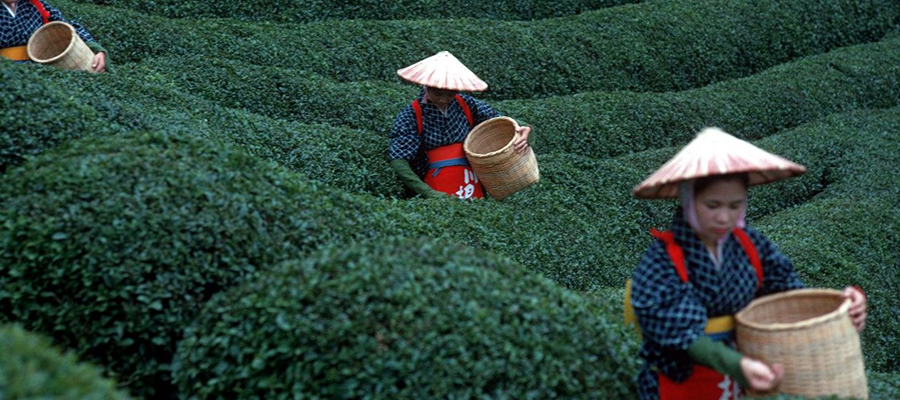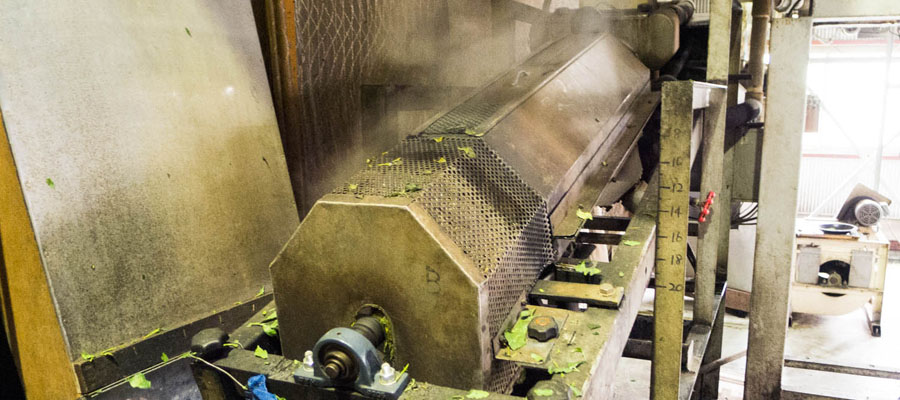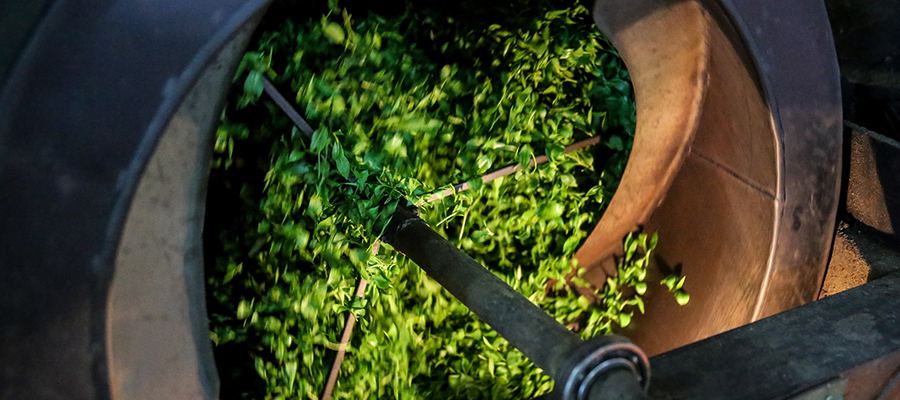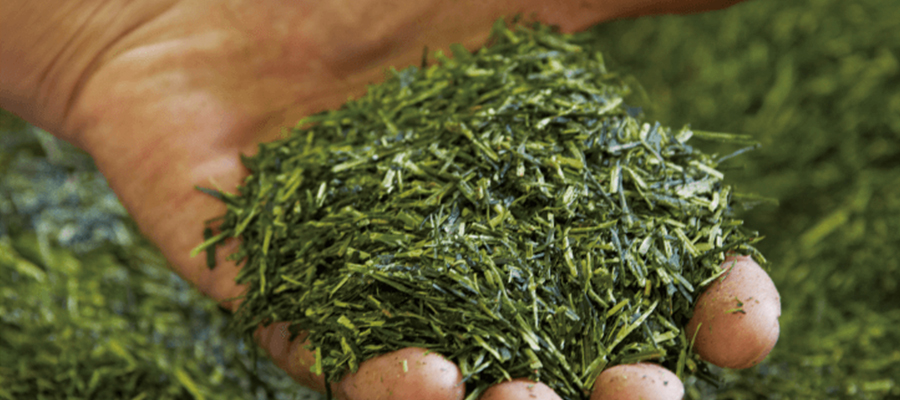All the tea varieties differ from each other because of the way they have been cultivated, processed and what part of the tea tree plant is used for a given tea. What distinguishes Japanese green tea from other teas (black tea and oolong tea) is that the tea leaves for Japanese green tea are steamed almost immediately after harvest to stop the leaves from oxidizing, where as Oolong tea is partially oxidized and black tea is fully oxidized. The steaming process preserves the nutritional value, antioxidants, aroma and color of the tea leaves and retains the original nature of the tea leaves.
Since all parts of the tea plant are highly valued the different parts are made into different types of tea. The process of some of the main types of Japanese green teas is clarified below.
Types of Green Tea
TEA VARIETIES
The Harvest

The Steaming Process

The Harvest

The Steaming Process

The Rolling & Drying Process

The Sorting Process

MATCHA
Matcha is the first and most traditional of Japanese green teas, literally means “rubbed tea”. Which is exactly what matcha is. Ceremonial grade matcha is ground (rubbed) to a powder in a granite mill. It is so fine, it will settle into the lines of your finger-print.
The Art of Matcha is traditionally used in the Japanese Tea Ceremony. It is also very good for personal meditation and relaxation. Matcha is a heavy and strong green tea powder and looks like “Green Tea Cappuccino”.
Matcha is made from shade-grown tea leaves also used to make Gyokuro. The preparation of Matcha starts several weeks before harvest & can last up to 20 days, when the tea bushes are covered to prevent direct sunlight. This slows down growth, turns the leaves a darker shade of green, and causes the production of amino acids. The dried leaves are ground to the fine, bright green, talc-like powder known as matcha.
It is an excellent ingredient to use for various recipes such as, green tea cake, green tea ice cream, green tea smoothies, green tea soft drink, green tea cocktail and green tea soup etc.
There are three harvests of the year, the first harvest being the highest in quality. Like Gyokuro, Matcha is shaded for 3 weeks to stop direct sunlight and to slow down the process of photosynthesis, because the more sunlight the leaves get the more bitter the tea becomes. The shading of the leaves retains the theanine component in the tea leaves which gives matcha and gyokuro its sweet, umami-rich delicous flavour.
The steaming process starts shortly after harvest plays a crucial part in the end result of the tea. The steaming process preserves the nutritional value, antioxidants, aroma and color of the green tea so that the tea conserves its original nature as much as it can.
The rolling process start soon after the steaming process and this process rolls the leaves shin and sharp. This process also plays a part in retaining the essence of the tea leaves by wrapping them individually, until the right temperature brewed water releases the elements of the tea.
The tea leaves undergo several drying sessions so that all the water content is gone when they reach the finish line for the packaged product.
The final step in the processing of matcha is the grinding of the tencha leaves into a fine powder. For about 800 years, the traditional method to accomplish this was to manually grind the tencha on a stone mill. Today tea producers use an automated stone mill, with the result being a superior consistency in the ultra-fine matcha powder.
GYOKURO
Gyokuro is a premium and unique Japanese green tea, widely recognized for its remarkable health benefits. The tea plants are shaded for about three weeks before harvest, reducing photosynthesis and enhancing the tea’s natural compounds.
This shading process boosts key ingredients such as catechins (especially EGCG), Theanine (a kind of amino acids),flavonoids, polysaccharides, fluoride, and vitamins B, C, and E, alongside a mild caffeine content. These compounds are linked to a range of health benefits, including relaxation, mental clarity, and cardiovascular support, primarily due to their potent antioxidant properties.
The name “Gyokuro” translates to “jewel dew” or “jade dew,” referring to the vivid green color of the brewed tea. Gyokuro has a sweet, delicate flavor with a soft texture, making it unique among green teas. Notably, it is the only green tea whose leaves can be consumed.
Note:
EGCG (Epigallocatechin gallate) is a potent catechin found in green tea. It has been extensively studied for its potential health benefits, including improving heart health, boosting metabolism, and providing anti-inflammatory and anti-cancer properties. EGCG also helps protect against oxidative stress and may reduce the risk of certain diseases.
There are three harvests of the year, the first harvest being the highest in quality. Gyokuro is shaded for 3 weeks to stop direct sunlight and to slow down the process of photosynthesis, because the more sunlight the leaves get the more bitter the tea becomes. The shading of the leaves retains the theanine component in the tea leaves which gives gyokuro its sweet, umami-rich delicious flavour. It is the only Japanese green tea leaf that can be eaten.
The steaming process starts shortly after harvest plays a crucial part in the end result of the tea. The steaming process preserves the nutritional value, antioxidants, aroma and color of the green tea so that the tea conserves its original nature as much as it can.
The rolling process start soon after the steaming process and this process rolls the leaves shin and sharp. This process also plays a part in retaining the essence of the tea leaves by wrapping them individually, until the right temperature brewed water releases the elements of the tea.
The tea leaves undergo several drying sessions so that all the water content is gone when they reach the finish line for the packaged product.
Only the finest twisted leaves will be packaged as Goykuro while the buds, stems and flakes are sorted and packaged separately, as Gyokuro Mecha, Gyokuro Karigane and Gyokuro-ko. Nothing is wasted of the tea plant because all parts are valued and respected in Japanese philosophy.
YABUKITA
Yabukita is the highest grade of Sencha. It is produced through a unique steaming process, done longer than any other green tea using only the youngest tea leaves.
Yabukita is harvested during the Sencha season, usually from early April to late May, centering on the 88th day after Setsubun which falls around February 4, a cross-quarter day traditionally considered the start of spring in Japan.
This gives Yabukita strong mellow flavour with sweet characteristics with a fresh green grass aroma. It also increases the natural vitamin content and antioxidants. Yabukita leaves can be eaten with any of mixed sauces after 2-3 infusions and is an excellent tea to enjoy in the evening.
There are three harvests of the year, the first harvest being the highest in quality. Unlike Gyokuro, Yabukita is exposed to full sun and it therefore contains a lot of vitamin C, tannin and high levels of catechins.
The steaming process starts shortly after harvest plays a crucial part in the end result of the tea. The steaming process preserves the nutritional value, antioxidants, aroma and color of the green tea so that the tea conserves its original nature as much as it can.
The rolling process start soon after the steaming process and this process rolls the leaves shin and sharp. This process also plays a part in retaining the essence of the tea leaves by wrapping them individually, until the right temperature brewed water releases the elements of the tea.
The tea leaves undergo several drying sessions so that all the water content is gone when they reach the finish line for the packaged product.
The buds, stems and flakes are sorted out and packaged individually as Sencha Mecha, Sencha Kukicha and Hanako. The larger, courser leaves and stems are also sorted aside for Bancha which then later on will be made into a few other types of teas, including Genmaicha.
SENCHA
Sencha has a fresh grassy flavor. Once harvested, the leaves are steam, rolled and then dried. It is the most popular tea in Japan, and represents about 80 percent of the tea produced in Japan.
Sencha was invented in the 18th century, and before then, all tea was lower-grade bancha (tea made from older leaves, sometimes roasted) or matcha, which is described above. These days most teas are infused, but back then, sencha’s name set it apart from the usual tea-whisking technique.
Enjoyed at any time of the day with a meal or after. It is a great drink to maintain good health through its natural Mineral and Vitamin content.
There are three harvests of the year, the first harvest being the highest in quality. Unlike Gyokuro, Sencha is exposed to full sun and it therefore contains a lot of vitamin C, tannin and high levels of catechins.
The steaming process starts shortly after harvest plays a crucial part in the end result of the tea. The steaming process preserves the nutritional value, antioxidants, aroma and color of the green tea so that the tea conserves its original nature as much as it can.
The rolling process start soon after the steaming process and this process rolls the leaves shin and sharp. This process also plays a part in retaining the essence of the tea leaves by wrapping them individually, until the right temperature brewed water releases the elements of the tea.
The tea leaves undergo several drying sessions so that all the water content is gone when they reach the finish line for the packaged product.
The buds, stems and flakes are sorted out and packaged individually as Sencha Mecha, Sencha Kukicha and Hanako. The larger, courser leaves and stems are also sorted aside for Bancha which then later on will be made into a few other types of teas, including Genmaicha.
GENMAICHA
Genmaicha is the Japanese name for green tea combined with roasted rice with added Matcha green tea powder. It is sometimes referred to colloquially as “popcorn tea” because a few grains of the rice pop during the roasting process and resemble popcorn.
Tea steeped from these tea leaves has a light green and yellow hue. Unlike other teas, Genmaicha is naturally balanced with Yin and Yang as it contains both tea leaves and rice grains. Its flavor is mild and combines the fresh grassy flavor of green tea with the aroma of the roasted rice Enjoy at any time of the day.
Genmaicha is the Japanese name for green tea combined with roasted rice. It is sometimes referred to colloquially as “popcorn tea” because a few grains of the rice pop during the roasting process and resemble popcorn.
Tea steeped from these tea leaves has a light green and yellow hue. Unlike other teas, Genmaicha is naturally balanced with Yin and Yang as it contains both tea leaves and rice grains. Its flavor is mild and combines the fresh grassy flavor of green tea with the aroma of the roasted rice Enjoy at any time of the day.
Sencha and Bancha (used for Yanagi, Hojicha and Genmaicha) are also from the first harvest of the year and have been fully exposed to sun from shoots to leaves that are ready for picking. When this batch of leaves has undergone all its preparations for packaging the size of the leaves will determine whether they will be categorised as Sencha or Bancha.
The steaming process starts shortly after harvest plays a crucial part in the end result of the tea. The steaming process preserves the nutritional value, antioxidants, aroma and color of the green tea so that the tea conserves its original nature as much as it can. In the case of Genmaicha there is an additional component to it – roasted rice. A highly favoured tea for a good reason with a nutty popcorn taste.
The rolling process start soon after the steaming process and this process rolls the leaves shin and sharp. This process also plays a part in retaining the essence of the tea leaves by wrapping them individually, until the right temperature brewed water releases the elements of the tea.
The tea leaves undergo several drying sessions so that all the water content is gone when they reach the finish line for the packaged product.
The buds, stems and flakes are sorted out and packaged individually as Sencha Mecha, Sencha Kukicha and Hanako while the larger, courser leaves and stems are also sorted aside for Bancha. Yanagi is sorted from the Bancha batch and the flavour is similar to sencha although a bit lighter. Yanagi is then used for Genmaicha along with roasted brown rice, which gives this tea a lovely nutty, popcorn flavour.
HOUJICHA
Houjicha is a Bancha or Sencha leaves that has been roasted. It is distinctive from other Japanese green teas because it is roasted in a porcelain pot over charcoal, whereas most Japanese teas are steamed. The tea is fired at a high temperature, altering the leaf color tints from green to reddish brown. With a very unique aroma, it is mild to the palate and a Caffeine-free tea.
Sencha and Bancha (used for Yanagi, Hojicha and Genmaicha) are also from the first harvest of the year and have been fully exposed to sun from shoots to leaves that are ready for picking. When this batch of leaves has undergone all its preparations for packaging the size of the leaves will determine whether they will be categorised as Sencha or Bancha.
The steaming process starts shortly after harvest plays a crucial part in the end result of the tea. The steaming process preserves the nutritional value, antioxidants, aroma and color of the green tea so that the tea conserves its original nature as much as it can. In the case of Hoijicha the leaves have an additional production step where the they are roasted, which gives the color and flavour of this unique variety of green tea.
The rolling process start soon after the steaming process and this process rolls the leaves shin and sharp. This process also plays a part in retaining the essence of the tea leaves by wrapping them individually, until the right temperature brewed water releases the elements of the tea.
The tea leaves undergo several drying sessions so that all the water content is gone when they reach the finish line for the packaged product.
The buds, stems and flakes are sorted out and packaged individually as Sencha Mecha, Sencha Kukicha and Hanako while the larger, courser leaves and stems are also sorted aside for Bancha. Bancha is then used for several other teas, including Hojicha which is roasted at high heat to give the unique, rich flavour of the tea. The roasting process takes away some of the caffeine and tannin components and this tea is therefore well suited for evening tea.
